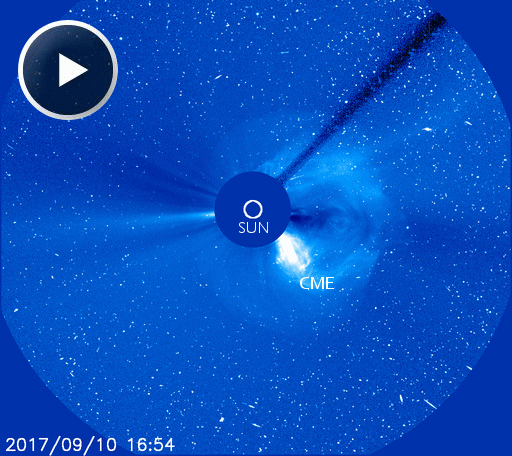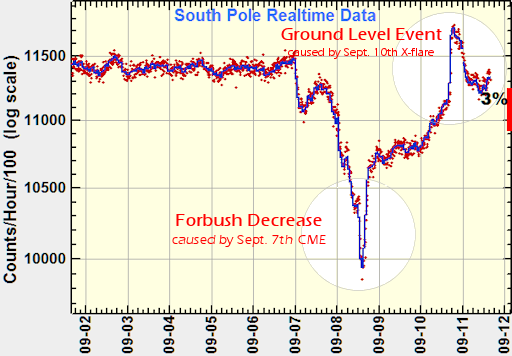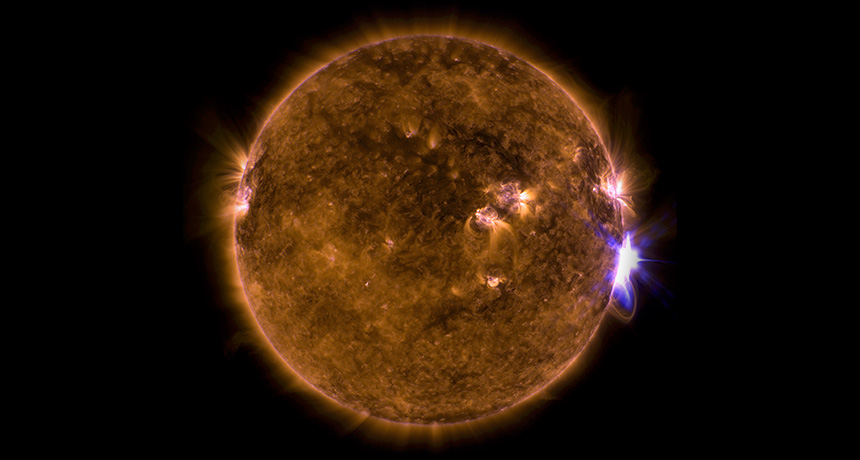At www.spaceweather.com (August 12th 2017) we learn another geomagnetic storm is predicted. This one is thought to be moderate in effect as it will be just a glancing blow which is unlike the one a few days ago, on the 10th. This was an X8 class flare, causing a solar radiation storm and leaving behind a blizzard of radiation …

 … Why was the flare so radioactive? It was the location of the flare when it erupted. The Sun's western limb is magnetically well connected with the Earth, it seems. Magnetic fields spiralling back from the blast site led directly to our planet, funneling energetic protons to Earth. Normally, solar radiation is held at bay by the magnetosphere but on September 10th there was a ground level event. Monitors in the Arctic and Antarctic, and other high latitude locations, detected a surge of particles reaching all the way to the surface of the Earth. In historical terms this was a relatively small ground level event – which contradicts some of the hype out there this week. It was just one thousandth of one in February 1956 (which is the largely so far recorded). Since 1942 there have been 73 ground level events detected by monitors.
… Why was the flare so radioactive? It was the location of the flare when it erupted. The Sun's western limb is magnetically well connected with the Earth, it seems. Magnetic fields spiralling back from the blast site led directly to our planet, funneling energetic protons to Earth. Normally, solar radiation is held at bay by the magnetosphere but on September 10th there was a ground level event. Monitors in the Arctic and Antarctic, and other high latitude locations, detected a surge of particles reaching all the way to the surface of the Earth. In historical terms this was a relatively small ground level event – which contradicts some of the hype out there this week. It was just one thousandth of one in February 1956 (which is the largely so far recorded). Since 1942 there have been 73 ground level events detected by monitors.
William also sent in a link to www.sciencenews.org/article/sun-solar-flares-paradox … which also asks, do the biggest flares occur as a solar cycle dips …
 … a series of rapid fire solar flares coincided with the downside of the current 11 solar cycle, between Sept 4th and Sept 10th (but we have yet another one on the 13th). Four of these were X class flares – one of them was X9.3 (the most powerful flare since 2006). It flung a blob of energetic plasma towards the Earth with aurorae visible as far south as Arkansas. The Sun is near the end of a very weak cycle (which began in 2008). The Sun's magnetic activity waxes and wanes roughly every 11 years, generating more sunspots at the peak of the cycle and fewer on the trough. When the cycle peaked in 2013 it was looking to be the weakest cycle in the last 100 years. However, peak flares came a few years after the sunspot maximum. Even stranger, the strongest flares tend to occur on the cycle's downslope. The biggest solar storm that has been recorded, the Carrington event in 1859, was an X45 – and it came on the back of a very weak solar cycle.
… a series of rapid fire solar flares coincided with the downside of the current 11 solar cycle, between Sept 4th and Sept 10th (but we have yet another one on the 13th). Four of these were X class flares – one of them was X9.3 (the most powerful flare since 2006). It flung a blob of energetic plasma towards the Earth with aurorae visible as far south as Arkansas. The Sun is near the end of a very weak cycle (which began in 2008). The Sun's magnetic activity waxes and wanes roughly every 11 years, generating more sunspots at the peak of the cycle and fewer on the trough. When the cycle peaked in 2013 it was looking to be the weakest cycle in the last 100 years. However, peak flares came a few years after the sunspot maximum. Even stranger, the strongest flares tend to occur on the cycle's downslope. The biggest solar storm that has been recorded, the Carrington event in 1859, was an X45 – and it came on the back of a very weak solar cycle.
